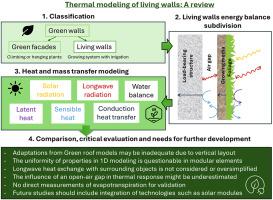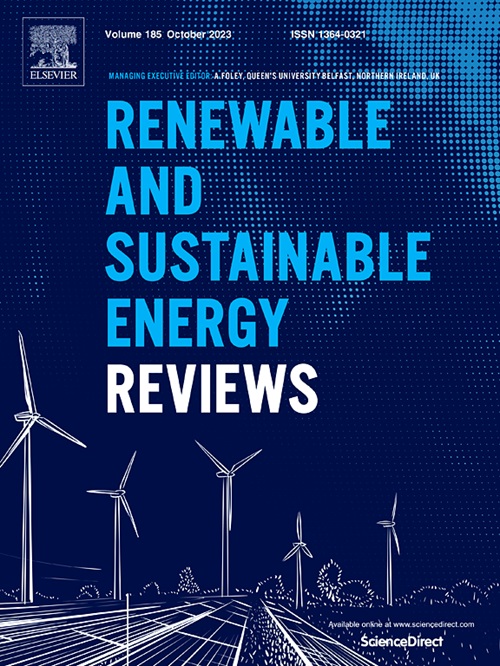活墙的热建模:综述
IF 16.3
1区 工程技术
Q1 ENERGY & FUELS
引用次数: 0
摘要
绿色(植被)建筑围护结构的环境效益已得到广泛认可。绿色(植被)建筑围护结构对提高建筑能效和改善城市小气候具有积极作用,例如,可减轻城市热岛效应,提高城市居住舒适度。活墙被认为是一种新兴技术,因此缺乏广泛实施和成熟的热响应模型。目前,以实验为导向的活墙研究占主导地位,而有关建模的研究却很少。本研究对传热和传质模型进行了详细综述,并分别考虑了各个机制。综述表明,现有模型主要采用了绿色屋顶模型中的传热和传质机制。然而,由于活墙的垂直布局,这种调整可能不适用于密集的城市环境。大多数研究还假定了特性的一致性,例如生机墙模块元件各列和各行的生长介质含水量,尽管这些特性可能会发生变化,并对热响应产生重大影响。研究还强调,露天间隙对活墙热响应(和建模)的影响可能被低估。所发现的建模差距可作为进一步开发数学模型的建议。这包括扩大考虑的边界条件、调整过于简化的假设以及强调进一步验证的必要性,这将促进活墙技术向可持续、节能和可靠的技术方向发展。本文章由计算机程序翻译,如有差异,请以英文原文为准。

Thermal modeling of living walls: A review
Green (vegetative) building envelopes are widely recognized for their environmental benefits. They have a positive effect on the energy efficiency of buildings and improve the urban microclimate, e.g. by mitigating urban heat island effects and increasing living comfort in cities. Living walls are considered an emerging technology and thus lack widely implemented and established models of thermal response. Experimentally oriented studies of living walls currently prevail, while research on modeling is scarce. This study presents a detailed review of the modeling of heat and mass transfer, considering the individual mechanisms separately. The review demonstrates that existing models primarily adopt heat and mass transfer mechanisms from green roof models. However, the adjustments may be inadequate for dense urban environments due to the vertical layout of living walls. Most studies also assume the uniformity of properties, such as growing media moisture content throughout columns and rows of living wall modular elements, although these properties can vary and significantly affect the thermal response. It is also highlighted that the influence of an open-air gap on living wall thermal response (and modeling) might be underestimated. Identified modeling gaps serve as recommendations for further development of mathematical models. This includes expanding considered boundary conditions, adjustments of oversimplified assumptions, and emphasizing the need for further validation, that will stimulate the development of living wall technology towards a sustainable, energy efficient and reliable technology.
求助全文
通过发布文献求助,成功后即可免费获取论文全文。
去求助
来源期刊

Renewable and Sustainable Energy Reviews
工程技术-能源与燃料
CiteScore
31.20
自引率
5.70%
发文量
1055
审稿时长
62 days
期刊介绍:
The mission of Renewable and Sustainable Energy Reviews is to disseminate the most compelling and pertinent critical insights in renewable and sustainable energy, fostering collaboration among the research community, private sector, and policy and decision makers. The journal aims to exchange challenges, solutions, innovative concepts, and technologies, contributing to sustainable development, the transition to a low-carbon future, and the attainment of emissions targets outlined by the United Nations Framework Convention on Climate Change.
Renewable and Sustainable Energy Reviews publishes a diverse range of content, including review papers, original research, case studies, and analyses of new technologies, all featuring a substantial review component such as critique, comparison, or analysis. Introducing a distinctive paper type, Expert Insights, the journal presents commissioned mini-reviews authored by field leaders, addressing topics of significant interest. Case studies undergo consideration only if they showcase the work's applicability to other regions or contribute valuable insights to the broader field of renewable and sustainable energy. Notably, a bibliographic or literature review lacking critical analysis is deemed unsuitable for publication.
 求助内容:
求助内容: 应助结果提醒方式:
应助结果提醒方式:


